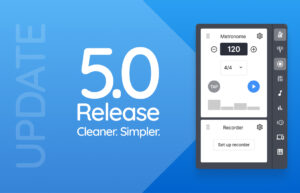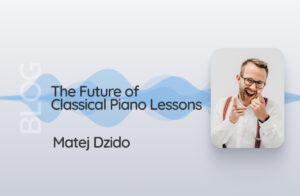I’m delighted to share my thoughts on piano practice with you in this article—a subject that occupies both students and teachers daily. Personally, I had to painstakingly learn the process of targeted piano practice. From a teacher’s perspective, the art lies in guiding students not just to play but to practice consciously. And for the students? They face the challenge of implementing these practice methods independently at home. Both perspectives are crucial for consistent progress on the instrument.
In this piece, I’d like to delve deeper into three key points:
- Why do so many fail at practicing?
- What constitutes a productive practice session?
- My top three ultimate practice tips for the piano.
The Challenges of Practicing
“I did much better at home, I made no mistakes”… I’m sure you’ve heard this, or similar lines, countless times. But during lessons, everything seems to fall into place when students are guided by their instructors. This got me thinking!
An intriguing article appeared just before Easter in the BR-Klassik magazine on this topic. Did you know it takes 30,000 correct repetitions to flawlessly play a passage that was previously learned incorrectly in a concert setting? Prof. Eckart Altenmüller, Professor of Music Physiology and Music Medicine, goes even further, stating it could take several months to correct a wrongly practiced passage. Even after 24 years of learning, performing, and teaching, I wasn’t entirely aware of this, but it sharpened my senses for the topic of practicing.
Questions like “Why do so many fail at practicing?” or “Why do kids seem to have a genuine aversion to practicing?” dominated my thoughts. And what distinguishes successful pianists from the less successful ones?
Asking the Right Questions
Our environment and everyday vocabulary are where the right questioning begins. “Did you play the piano today?” is a familiar prompt from parents trying to remind their children to practice. From a psychological standpoint, “playing” sounds more motivating than “practicing”, but then it often remains just “playing”. They might repeat their favorite passage two or three times, then end their “practice session” before it truly begins. They try to play the piece from start to finish, mistakes creep in, consciously or unconsciously, leading to frustration and ultimately stopping.
The issue with asking “Did you play the piano today?” is the lack of a specific objective. A better question might be “What did you play today?” or even better, “What did you practice today?”. From a student’s perspective, the question should be “What do I want to be better at after practicing compared to before?”. This is the most crucial question for both musicians and students before every practice session.
I’ve observed that when my students answer this essential question in writing, they practice with greater focus and maintain a sustained joy and progress in their practice. Another aspect of this approach deals with the transformation process that practice represents—the transition from the current state to the desired state, where progress in piano playing occurs.
Lack of Practice Methods
The transformation process fails when students lack practice methods to tackle specific challenges on their own. For example, how do I practice a section that demands improved coordination between the left and right hand? How do I approach a segment with rhythmic challenges? How do I practice fast runs with complex sequences or jumps?
As an instructor, I need to actively ask my students these questions during lessons, guiding and documenting their progress so they can replicate these transformations at home through repeated practice. Without tested strategies and step-by-step guidelines, mere advice like “It needs more time” or “Just repeat it a few more times” won’t work. Without progress or success, students get disheartened and give up.
This leads to the second major question of this article: what makes a good practice session?
- A clear objective: What do I want to improve after practicing compared to before?
- A diverse toolkit of methods to tackle any challenge playfully.
- An audio recording device to document your practice, allowing reflection. Often, even the memo function on a smartphone will suffice.
In conclusion, I’d like to share three ultimate practice tips that have helped my students in the past. I invite you to pass them on to your students or even try them out in your lessons.
Exercise 1: Hand Coordination
Goal: Improve coordination between the left and right hand. For students struggling to coordinate both hands and wanting to add more flow to a passage:
- Playthrough 1: Play the right hand slowly on the piano and tap the left hand on the left thigh. Voice the sequence aloud.
- Playthrough 2: Reverse roles. Play the left hand on the piano and tap the right hand on the right thigh.
- Playthrough 3: Play both hands slowly on the piano. For challenging segments, repeat playthroughs 1 and 2 slowly three to five times.
Exercise 2: Practicing Rhythmic Patterns
Goal: Convey a rhythmic figure. Ask students to breathe deeply and set their hands in the starting position. Then, focus on understanding the rhythmic pattern, voicing it aloud, tapping it, and finally playing it on the piano. Use repetition for mastery.
Exercise 3: Fast Runs, Sequences, or Jumps
Goal: Playing a section without mistakes at the desired tempo.
- Step 1: Break the sequence down into small units and play each unit slowly. Focus on transitions between the units.
- Step 2: Play the entire sequence at a slower tempo than desired.
- Step 3: Gradually increase the tempo, ensuring accuracy is maintained.
Conclusion
Every student is unique. These exercises may not fit all situations, but they offer a starting point. It’s important to understand that piano practice isn’t just about repetition—it’s about awareness, strategy, and constant reflection. Emphasize to your students that their approach to practicing is just as important as their actual playing.
I am passionate about encouraging students to dive right into piano practice. Ahead of them lies a journey filled with creativity. Let’s work together to enhance their skills, amplifying the joy they feel when their fingers glide mindfully over the keys.
Warm musical greetings from the City of Mozart, Salzburg,
Matej Dzido
Concert Pianist, Piano Instructor, and Founder of Pianofly Piano School
About the Author

Matej Dzido completed his studies in Instrumental and Vocal Pedagogy at the Mozarteum University in Salzburg, earning unanimous distinction in Piano under Prof. Dr. Stan Ford. Since 2015, he has served as an independent product specialist and demonstrator for various Yamaha keyboard instruments. Currently, Matej is touring both nationally and internationally with his latest concert project, “Beethoven in Havana”, conducting workshops and masterclasses. In 2021, he founded the Pianofly Online Academy. His students have consistently won first-place awards at the prestigious Prima La Musica youth competition. Henrik R., 14, was accepted last year into the Pre-College Jungstudium in piano at the University Mozarteum Salzburg.











